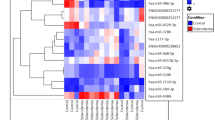Abstract
MicroRNAs are short, 18- to 25-nt sequences of noncoding, single-stranded RNA that function as regulatory molecules and participate in a series of vital processes including early development, cell proliferation, cell differentiation, apoptosis, substance metabolism and the pathogenesis of human diseases. This study compared the microRNA profiles of patients with systemic scleroderma (SSc) and healthy control individuals to investigate the pathogenesis of SSc. Skin tissue was isolated from three patients with SSc and three healthy controls. miRNA microarray chip analysis identified 24 miRNAs that were differentially expressed in patients with SSc and 6 microRNAs that may be correlated with the pathogenesis of SSc. The results of the microarray analysis were confirmed using real-time PCR. This work suggests that miRNAs may be potential diagnosis biomarkers and are likely to be involved in the pathogenesis of SSc.










Similar content being viewed by others
References
Mayes MD, Lacey JV Jr, Beebe-Dimmer J, Gillespie BW, Cooper B, Laing TJ, Schottenfeld D (2003) Prevalence, incidence, survival, and disease characteristics of systemic sclerosis in a large US population. Arthritis Rheum 48:2246–2255
Sakkas LI (2005) New developments in the pathogenesis of systemic sclerosis. Autoimmunity 38:113–116
Nelson JL (1999) Microchimerism and scleroderma. Curr Rheumatol Rep 1:15–21
Giusti B, Serrati S, Margheri F, Papucci L, Rossi L, Poggi F, Magi A, Del Rosso A, Cinelli M, Guiducci S, Kahaleh B, Matucci-Cerinic M, Abbate R, Fibbi G, Del Rosso M (2005) The antiangiogenic tissue kallikrein pattern of endothelial cells in systemic sclerosis. Arthritis Rheum 52:3618–3628
Tan FK, Hildebrand BA, Lester MS, Stivers DN, Pounds S, Zhou X, Wallis DD, Milewicz DM, Reveille JD, Mayes MD, Jin L, Arnett FC Jr (2005) Classification analysis of the transcriptosome of nonlesional cultured dermal fibroblasts from systemic sclerosis patients with early disease. Arthritis Rheum 52:865–876
Ahmed SS, Tan FK (2003) Identification of novel targets in scleroderma: update on population studies, cDNA arrays, SNP analysis, and mutations. Curr Opin Rheumatol 15:766–771
Zhou X, Tan FK, Xiong M, Arnett FC, Feghali-Bostwick CA (2005) Monozygotic twins clinically discordant for scleroderma show concordance for fibroblast gene expression profiles. Arthritis Rheum 52:3305–3314
Luzina IG, Atamas SP, Wise R, Wigley FM, Xiao HQ, White B (2002) Gene expression in bronchoalveolar lavage cells from scleroderma patients. Am J Respir Cell Mol Biol 26:549–557
Zhou X, Tan FK, Xiong M, Milewicz DM, Feghali CA, Fritzler MJ, Reveille JD, Arnett FC (2001) Systemic sclerosis (scleroderma): specific autoantigen genes are selectively overexpressed in scleroderma fibroblasts. J Immunol 167:7126–7133
Whitfield ML, Finlay DR, Murray JI, Troyanskaya OG, Chi JT, Pergamenschikov A, McCalmont TH, Brown PO, Botstein D, Connolly MK (2003) Systemic and cell type-specific gene expression patterns in scleroderma skin. Proc Natl Acad Sci USA 100:12319–12324
Ambros V (2004) The functions of animal microRNAs. Nature 431:350–355
Bartel DP (2004) MicroRNAs: genomics, biogenesis, mechanism, and function. Cell 116:281–297
Croce CM, Calin GA (2005) miRNAs, cancer, and stem cell division. Cell 122:6–7
Czech MP (2006) MicroRNAs as therapeutic targets. N Engl J Med 354:1194–1195
Lim LP, Lau NC, Garrett-Engele P, Grimson A, Schelter JM, Castle J, Bartel DP, Linsley PS, Johnson JM (2005) Microarray analysis shows that some microRNAs downregulate large numbers of target mRNAs. Nature 433:769–773
Lu J, Getz G, Miska EA, Alvarez-Saavedra E, Lamb J, Peck D, Sweet-Cordero A, Ebert BL, Mak RH, Ferrando AA, Downing JR, Jacks T, Horvitz HR, Golub TR (2005) MicroRNA expression profiles classify human cancers. Nature 435:834–838
Sonkoly E, Wei T, Janson PC, Saaf A, Lundeberg L, Tengvall-Linder M, Norstedt G, Alenius H, Homey B, Scheynius A, Stahle M, Pivarcsi A (2007) MicroRNAs: novel regulators involved in the pathogenesis of Psoriasis? PLoS One 2:e610
Dai Y, Huang YS, Tang M, Lv TY, Hu CX, Tan YH, Xu ZM, Yin YB (2007) Microarray analysis of microRNA expression in peripheral blood cells of systemic lupus erythematosus patients. Lupus 16:939–946
Thomson JM, Parker J, Perou CM, Hammond SM (2004) A custom microarray platform for analysis of microRNA gene expression. Nat Methods 1:47–53
Wallace DC (1999) Mitochondrial diseases in man and mouse. Science 283:1482–1488
Verrecchia F, Mauviel A, Farge D (2006) Transforming growth factor-beta signaling through the smad proteins: role in systemic sclerosis. Autoimmun Rev 5:563–569
Smith EA, LeRoy EC (1990) A possible role for transforming growth factor-beta in systemic sclerosis. J Invest Dermatol 95:125S–127S
Distler JH, Jungel A, Kowal-Bielecka O, Michel BA, Gay RE, Sprott H, Matucci-Cerinic M, Chilla M, Reich K, Kalden JR, Muller-Ladner U, Lorenz HM, Gay S, Distler O (2005) Expression of interleukin-21 receptor in epidermis from patients with systemic sclerosis. Arthritis Rheum 52:856–864
Hebbar M, Jeannin P, Magistrelli G, Hatron PY, Hachulla E, Devulder B, Bonnefoy JY, Delneste Y (2004) Detection of circulating soluble CD28 in patients with systemic lupus erythematosus, primary Sjogren’s syndrome and systemic sclerosis. Clin Exp Immunol 136:388–392
Gardner HA (1999) Integrin signaling in fibrosis and scleroderma. Curr Rheumatol Rep 1:28–33
Cho JW, Cha YC, Lee KS (2008) AP-1 transcription factor decoy reduces the TGF-beta1-induced cell growth in scleroderma fibroblasts through inhibition of cyclin E. Oncol Rep 19:737–741
Acknowledgments
The authors thank the patients and healthy volunteers who participated in this study and the workers of Dermatology and Venereology Department, Beijing Military Command General Hospital of PLA, who helped with this research.
Conflict of interest
The authors have declared that no conflict of interest exists.
Author information
Authors and Affiliations
Corresponding author
Additional information
An erratum to this article can be found at http://dx.doi.org/10.1007/s00296-011-2165-7.
Rights and permissions
About this article
Cite this article
Li, H., Yang, R., Fan, X. et al. MicroRNA array analysis of microRNAs related to systemic scleroderma. Rheumatol Int 32, 307–313 (2012). https://doi.org/10.1007/s00296-010-1615-y
Received:
Accepted:
Published:
Issue Date:
DOI: https://doi.org/10.1007/s00296-010-1615-y




